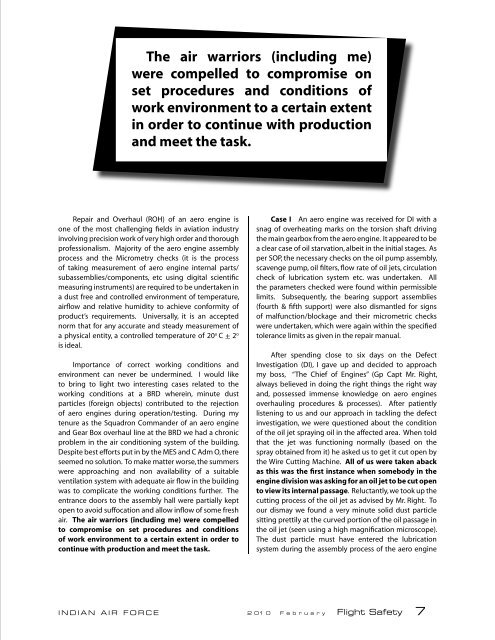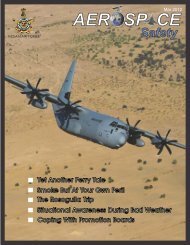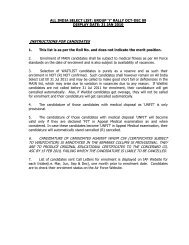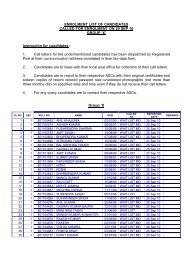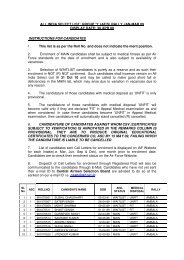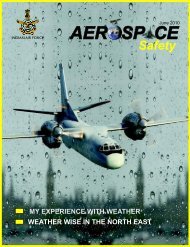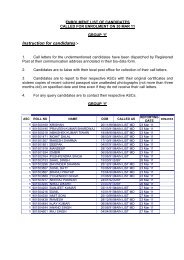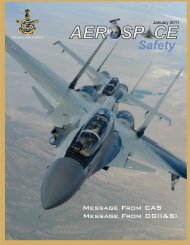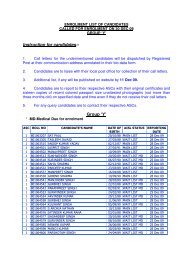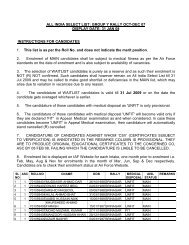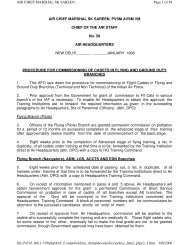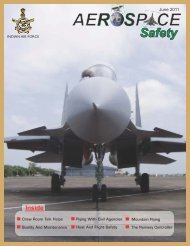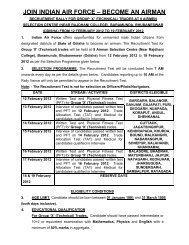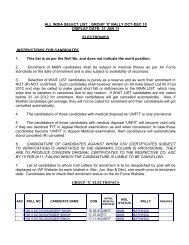February 2010 - Indian Airforce
February 2010 - Indian Airforce
February 2010 - Indian Airforce
Create successful ePaper yourself
Turn your PDF publications into a flip-book with our unique Google optimized e-Paper software.
The air warriors (including me)<br />
were compelled to compromise on<br />
set procedures and conditions of<br />
work environment to a certain extent<br />
in order to continue with production<br />
and meet the task.<br />
Repair and Overhaul (ROH) of an aero engine is<br />
one of the most challenging fields in aviation industry<br />
involving precision work of very high order and thorough<br />
professionalism. Majority of the aero engine assembly<br />
process and the Micrometry checks (it is the process<br />
of taking measurement of aero engine internal parts/<br />
subassemblies/components, etc using digital scientific<br />
measuring instruments) are required to be undertaken in<br />
a dust free and controlled environment of temperature,<br />
airflow and relative humidity to achieve conformity of<br />
product’s requirements. Universally, it is an accepted<br />
norm that for any accurate and steady measurement of<br />
a physical entity, a controlled temperature of 20 o C + 2 o<br />
is ideal.<br />
Importance of correct working conditions and<br />
environment can never be undermined. I would like<br />
to bring to light two interesting cases related to the<br />
working conditions at a BRD wherein, minute dust<br />
particles (foreign objects) contributed to the rejection<br />
of aero engines during operation/testing. During my<br />
tenure as the Squadron Commander of an aero engine<br />
and Gear Box overhaul line at the BRD we had a chronic<br />
problem in the air conditioning system of the building.<br />
Despite best efforts put in by the MES and C Adm O, there<br />
seemed no solution. To make matter worse, the summers<br />
were approaching and non availability of a suitable<br />
ventilation system with adequate air flow in the building<br />
was to complicate the working conditions further. The<br />
entrance doors to the assembly hall were partially kept<br />
open to avoid suffocation and allow inflow of some fresh<br />
air. The air warriors (including me) were compelled<br />
to compromise on set procedures and conditions<br />
of work environment to a certain extent in order to<br />
continue with production and meet the task.<br />
Case I An aero engine was received for DI with a<br />
snag of overheating marks on the torsion shaft driving<br />
the main gearbox from the aero engine. It appeared to be<br />
a clear case of oil starvation, albeit in the initial stages. As<br />
per SOP, the necessary checks on the oil pump assembly,<br />
scavenge pump, oil filters, flow rate of oil jets, circulation<br />
check of lubrication system etc. was undertaken. All<br />
the parameters checked were found within permissible<br />
limits. Subsequently, the bearing support assemblies<br />
(fourth & fifth support) were also dismantled for signs<br />
of malfunction/blockage and their micrometric checks<br />
were undertaken, which were again within the specified<br />
tolerance limits as given in the repair manual.<br />
After spending close to six days on the Defect<br />
Investigation (DI), I gave up and decided to approach<br />
my boss, “The Chief of Engines” (Gp Capt Mr. Right,<br />
always believed in doing the right things the right way<br />
and, possessed immense knowledge on aero engines<br />
overhauling procedures & processes). After patiently<br />
listening to us and our approach in tackling the defect<br />
investigation, we were questioned about the condition<br />
of the oil jet spraying oil in the affected area. When told<br />
that the jet was functioning normally (based on the<br />
spray obtained from it) he asked us to get it cut open by<br />
the Wire Cutting Machine. All of us were taken aback<br />
as this was the first instance when somebody in the<br />
engine division was asking for an oil jet to be cut open<br />
to view its internal passage. Reluctantly, we took up the<br />
cutting process of the oil jet as advised by Mr. Right. To<br />
our dismay we found a very minute solid dust particle<br />
sitting prettily at the curved portion of the oil passage in<br />
the oil jet (seen using a high magnification microscope).<br />
The dust particle must have entered the lubrication<br />
system during the assembly process of the aero engine<br />
INDIAN AIR FORCE 2 01 0 F e b r u a r y Flight Safety<br />
7


